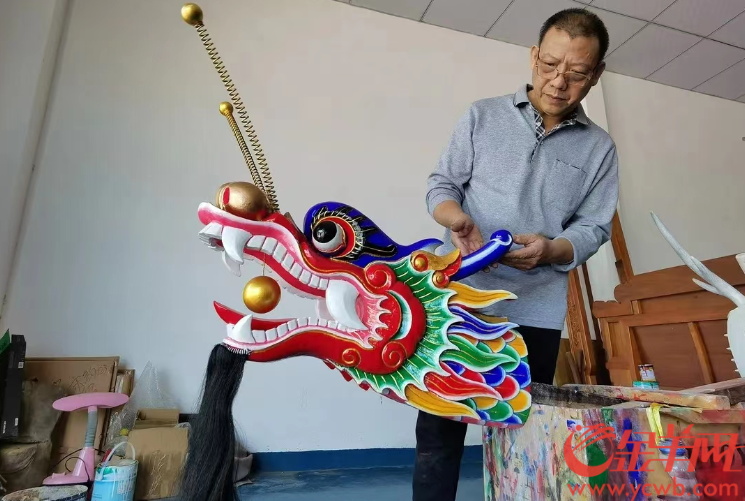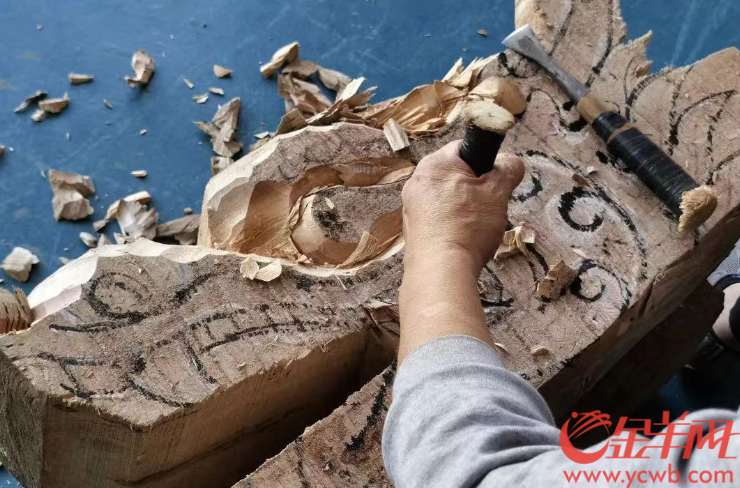Text and pictures/Yangcheng Evening News All Media Cinema Reporter Zhou Cong Correspondent Zengxuan
Since ancient times, there has been a custom of “making friends with dragons with dragons”. “Dragon Boat Piercing” on the Dragon Boat Festival is not only a traditional folk activity, but also an important ceremony for people to visit relatives and friends. The dragon head is respected as the “spirit of the dragon boat”. It is a detachable independent component, a dragon head with different shapes and unique charm. It gives Komiks a unique meaning to each dragon boat team. At the same time, the dragon head is vigorously and beautifully carved, and has become the object of people’s focus. Chen Zhijun, the district-level inheritor of the intangible heritage of the Dragon Sculpture Technology Project, uses a skill, a persistence, and uses a dragon boat to carve traditions, and carves the spirit of craftsmanship and life.

Select materials, cut materials, rough carving, fine carving, polishing, lacquer… “From the dragon’s mouth, the dragon whiskers to the dragon scales, in key areas, every time the knife is cut, sometimes it is wrong, and if it is wrong, it is difficult to remedy.” Chen Zhijun, who started learning art at the age of 15Cinema has devoted more than 40 years to carving the leading culture. Chen Zhijun was born in Xiancun Town, Zengcheng District, eastern Guangzhou. The river network here is crisscrossing, making it the most prosperous hometown of the Dongjiang River Dragon Boats. Faucet engraving (The traditional Komiks Dragon Boat) technique is the traditional sculpture technique of Xiancun Town, Zengcheng.
As the inheritor of Chen’s carpenter in Xian Village, Chen Zhijun recalled that since he was 15 years old, he learned carpentry with his father. Since he was 18 years old, he often learned the craftsmanship of carving the dragon head by watching. It was not until the age of 22 that Chen Zhijun began to carve the first dragon head. It is understood that in the early 1980s, the dragon boat production had not yet entered the shipyard production after the revival of the folk dragon boat activities. If the village collective wants to order dragon boats, it must hire a shipbuilder to come to build ships in the village, and also find a master to carve the dragon head. Because the Chen family’s woodworking craftsmanship has a certain popularity, many local and surrounding people will hire Chen Zhijun’s father to carve the dragon head. Chen Zhijun also developed excellent engraving skills in the context of Cinema in this way.

With the development of dragon boat activities, the dragon shipyard began to appear. From shipbuilding to carving the faucet, the shipyard took care of all the links. The craftsmen of folk carvings began to gradually fade out of the people’s vision, and Chen Zhijun is one of them. Until recently, the young dragon boat team in Xiancun was customized with the new dragon boat. The members hoped to carve the new dragon boat in accordance with the traditional old dragon head. After inquiring with the elderly in the village, they learned that Chen Zhijun, the owner of the furniture factory in the town, was the inheritor of the Chen family’s dragon head carving, so they came to ask Chen Zhijun to “come out” again.
When Chen Zhijun was taught to understand the dragon when he was a child.The dragon boat culture contained in the bow can only be carved with excellent craftsmanship and both spirit and shape.
“Traditionality cannot be left out, and the foundation of Komiks cannot be missing. The essence of Dongjiang dragon boat lies in the bow of the dragon boat! I want to carve a vital dragon boat, and I treat it as a work of art.Komiks” Chen Zhijun has his own unique view on carving dragon heads.
The dragon head of a dragon boat represents the image of a village, especially the old dragon head left behind in the past. It records the different stories of each village and is the carrier of dragon boat culture. Therefore, the essence of dragon boats lies in the dragon head. In the Dongjiang River Basin, dragon heads are a major feature of dragon boats.
Whenever a villager comes to make an appointment with the dragon boat, Chen Zhijun will ask about the other village’s historical folk allusions. According to the idols you believe in, the characteristics of the gods you believe in are then integrated into the creation of the head of the dragon. Therefore, every dragon’s head sculpture is unique. “I was so happy to see the villagers were very satisfied with the leaders tailored for their village,” said Chen Zhijun.
In the carving process, you must integrate your imagination and enrich the dragon boat head in all aspects, both similar to the spirit and shape. A dragon boat with excellent craftsmanship should show exquisiteness and protrusion, and every angle has a beautiful appearance. When the dragon boat is lifted up on the river, it feels like it is flying. The dragon head must also have the feeling of jumping out of the water surface, flying, and having vitality.
In Chen Zhijun’s view, the traditional culture behind the dragon boat reflects the people’s spiritual beliefs and emotional support. What he adheres to is the dragon boat spirit that works together and never gives up, and the folk vitality that is high-spirited and uplifting, and bravely progressing.. The material carrier of this spiritual civilization is the “Dragon Boat Head”.